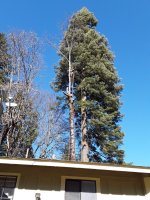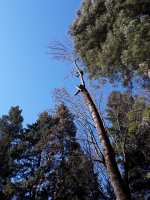It is possible to fell a tree 180˚ from it's direction of lean with just a chainsaw and some felling wedge (no ropes, cables, or tractors required) and to do so with a high degree of accuracy. If this is a skill you'd like to develop anyway, you are in luck, because one of the better chainsaw instruction organizations in New England,
Northeast Woodland Training is based in Middletown Springs, VT (probably not too far from you, if you are in southern VT). They offer instruction throughout Vermont - In fact, they have some coming up in Rupert and in Hartford in May (and some other ones further north before then).
I've been through their training and it's a great way to expand your capabilities and increase your safety when working in the woods. I've seen chainsaw novices drop trees on a target stake driven into the ground 40 feet away after taking their level 1 class, and hitting the stake in a direction significantly different than where the tree "wants" to go in their level 2 class.
My suggestion for you would be to start with their level 1 class (their relatively new "Basic Use and Safety" class is aimed at people who have no interest in tree felling - it's really just a basic intro to using a chainsaw class). If you are serious about it, consider signing up for the Level 1 and Level 2 classes, then decide if you want to go further based on how those go. Descriptions and course outlines are on their website.
However, no matter how good the instruction is, tackling trees against their lean in an area right next to some "high value targets" (i.e. your shed and propane tanks) is probably not the best idea fresh out of the classes. You'll want to spend a fair amount of time actually using the techniques on similar trees in lower-risk situations to develop the skills to handle what you describe in an area where the consequences of a mistake are more serious than dinging up a tree that you wanted to keep.
Perhaps the most important skill any chainsaw user can have is the judgement to know when to walk away because the job exceeds either their skill level or the capabilities of the equipment they have at hand. Given your descriptions in this thread, I think you are on the right track to tackle the easy ones yourself, and hire someone to handle the higher-risk felling.


